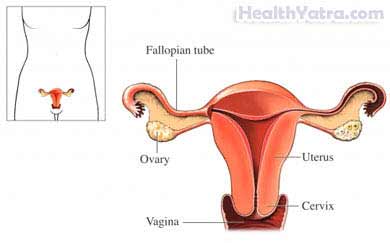تعريف
This procedure uses a hysteroscope to view the inside of a woman’s uterus (womb). A hysteroscope is a long, thin telescope with a camera on the end. Other small, surgical tools may also be inserted into the uterus through the hysteroscope.

أسباب هذا الإجراء
Hysteroscopy is done for:
- Diagnostic reasons—to examine the inner uterus to identify problems or abnormalities; may be done if you have:
- Repeated miscarriages
- العقم
- An abnormal Pap test
- Abnormal or postmenopausal uterine bleeding
- Therapeutic reasons—to correct anatomic problems and defects in the uterus; may be done for:
- Endometrial ablation —removal of uterine lining from the uterus
- Myomectomy —removal of fibrous or muscular tissue (fibroids)
- Removal of polyps (usually noncancerous)
- Removal of intrauterine devices (IUDs)
The result of the hysteroscopy depends on the reason for the procedure. In some cases, the doctor may be able to treat a condition right away. In other cases, you may need further surgery or other treatment.
المضاعفات المحتملة
Complications are rare. But, no procedure is completely free of risk. If you are planning to have hysteroscopy, your سيقوم الطبيب بمراجعة القائمة of possible complications. These may include:
- تورم أو نزيف
- العدوى
- Organ injury
- رد فعل للتخدير
تشمل العوامل التي قد تزيد من خطر حدوث مضاعفات ما يلي:
- History of pelvic inflammatory disease
- Inflammation of the cervix
- Distended bladder
- Pregnancy or possible pregnancy
- Allergies to surgical materials (eg, iodine, latex, medicines, anesthetics)
تأكد من مناقشة هذه المخاطر مع طبيبك قبل الإجراء.
ما يمكن توقعه
قبل الإجراء
Your doctor will ask about your medical history, medicines, and allergies. A physical exam will be done. Blood tests may also be done.
قبل الإجراء:
- التحدث مع طبيبك عن الأدوية الخاصة بك. قد يطلب منك التوقف عن تناول بعض الأدوية تصل إلى أسبوع واحد قبل العملية مثل:
- Anti-inflammatory drugs (eg, aspirin)
- مميعات الدم ، مثل كلوبيدوجريل أو وارفارين
- Arrange to have someone drive you home. Also, arrange for help at home.
- If instructed, eat a light meal the night before the surgery. Do not eat or drink anything after midnight.
التخدير
Depending on the reason for the hysterscopy, your doctor may use:
- General anesthesia —blocks pain and keeps you asleep through the surgery; used for therapeutic procedure
- Regional anesthesia—numbs one area of the body; used for diagnostic or therapeutic procedure
- Local anesthesia—just the area that is being operated on is numbed; given as an injection and may also be given with a sedative; used for diagnostic procedure
وصف الإجراء
A device called a speculum will be inserted into the vagina. It will hold your vagina open and allow instruments to enter easily. The doctor will clean the vagina and may dilate the cervix. The hysteroscope will then be put into the uterus through the vagina and dilated cervix. The uterus will be filled with carbon dioxide gas or a liquid. This will cause the uterus to inflate, allowing the doctor to get a closer, clear look at the uterine walls.
If you are having the procedure done for diagnostic reasons, the doctor will examine the uterus for abnormal tissue. A biopsy may be taken. Or, the uterine walls may be swabbed to get cell samples.
If you are having the procedure done for therapeutic reasons, the doctor may insert small surgical tools through the hysteroscope. The doctor will use the tools to remove diseased tissue and make repairs. In some cases, the doctor will use another viewing tube called a laparoscope. It will be passed into the abdomen. This allows the doctor to monitor the outside of the uterus and detect any possible perforation of the uterus by the hysteroscope.
كم من الوقت سيستغرق ؟
About 15-45 minutes (or longer for therapeutic procedure)
كم هو مؤلم ؟
You will have mild cramping and soreness. Ask your doctor about pain medicine.
رعاية ما بعد العملية
When you return home after the procedure, do the following to help ensure a smooth recovery:
- Rest as needed. Ask for someone to help you at home.
- Recovery time is short. Return to your normal activities the day after the procedure.
- Do not take medicine without your doctor’s approval. Some medicines may make bleeding worse.
- You may have difficulty using the bathroom for a few hours after the procedure. You may also have watery or bloody vaginal discharge for 3-4 weeks.
- You may have some bleeding or discharge from your vagina for several days postsurgery. A sanitary napkin or pad may be worn.
- Talk to your doctor about when it is okay to have الجنس, use tampons, or put anything else in the vagina.
- تأكد من اتباع تعليمات طبيبك.
استدعاء الطبيب
بعد وصوله الى المنزل ، اتصل بطبيبك إذا كان أي من الحالات التالية:
- علامات الإصابة, بما في ذلك حمى وقشعريرة
- Abnormal bleeding (more than a menstrual period)
- Foul-smelling vaginal discharge
- ألم في البطن
- Nausea, vomiting
- Cough, shortness of breath, difficulty swallowing, or chest pain
- Trouble urinating
- أي مخاوف أخرى
في حالة الطوارئ ، اتصل على المساعدة الطبية على الفور.
